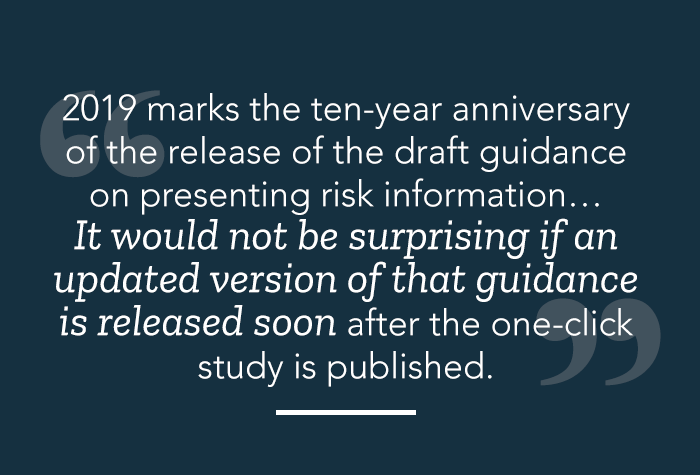
An Interview with Regulatory Expert Dale Cooke – 2019 Expectations – December 2018

For people working in pharma marketing and the use of digital technology for healthcare, 2018 was a remarkable year. FDA finalized two guidances about what claims marketers can make, and in the process greatly expanded the realm of possibilities. 2018 also saw DTC advertising of prescription drugs again in the crosshairs, as both industry and government proposed changes.
What can people expect in 2019?
Drug pricing isn’t going away.
The intense focus on the allegedly high prices charged for prescription drugs is going to grow. The updated DTC principles from the Pharmaceutical Research and Manufacturers of America (PhRMA) will take effect in April. According to those principles, manufacturers must provide consumers a way to get pricing information in their TV ads. Even prior to the April 15 effective date, people will start to see ads including more pricing information as companies start to comply with the updated principles. It’s unclear what information companies will be providing and whether consumers will find this information useful. Savvy marketers will pay attention to how consumers react to greater transparency.
A House of Representatives controlled by the Democratic party might find common cause with Republicans to push for additional movement on this front, and the new proposed rule by the Center for Medicare and Medicaid Services might be finalized at some point. Finally, the 2020 presidential race will start up in earnest. If the midterm elections were any guide, healthcare is going to remain at the center of the political maelstrom, and drug pricing is the current piñata being beaten by politicians wanting to appear tough on tackling the costs of healthcare. Until the focus changes, industry should expect additional proposals, Congressional hearings, etc.
At the same time that these pressures on revealing and limiting drug pricing are happening, industry is developing new types of treatments whose value is estimated at several million dollars per patient. Although the pricing for these products hasn’t yet been released, the availability of such treatments will strain existing payment models.
Privacy concerns will come to a head.
The new California privacy law comes into effect on January 1, 2020. 2019 will be a year where all of the big tech platforms will be updating their policies and (in some cases) functionality to ensure compliance. It is quite possible that concerns from the technology companies themselves as well as ongoing consumer group efforts will lead to the passage of national legislation to preempt the California law.
Regardless of the whether any laws change, the seemingly endless stream of stories about data breaches, sharing data with advertisers, and concerns about targeting on technology platforms will lead to changes in the way advertisers are able to use these platforms. Marketers should expect to see some targeting options disappear and should proactively look into their current strategies asking themselves how those strategies would look if published on the front page of the New York Times.
FDA studies and guidance to come.
In 2017, FDA announced its one-click study to look at providing risk information separate from benefit information in prescription drug advertising. That study should be released at some point in 2019. Its results will almost definitely have an impact on new guidance from the Agency.
Speaking of new guidance from the Agency, 2019 marks the ten-year anniversary of the release of the draft guidance on presenting risk information. For several years, that guidance has been on the agenda as one that the FDA is updating. It would not be surprising if an updated version of that guidance is released soon after the one-click study is published. It also would not be surprising to have the new version include information about online communications. The omission of any discussion of online communications was one of the primary criticisms of that guidance in 2009 when it was initially released.

FDA’s social sciences team has more studies underway beyond the one-click study. Several recent guidances, including the quantitative information in DTC advertising guidance from October, show the influence of that team’s work. Keeping abreast of the social science team’s work provides an early indicator of where FDA is likely to focus next.
FDA’s digital health initiative will accelerate.
FDA launched a significant effort in December of 2017 to foster the development and adoption of digital health tools. 2018 saw the FDA release a new framework for the development of apps by pharmaceutical manufacturers. Although not yet implemented, this framework, if adopted, would reduce the burden on manufacturers for developing apps tied to their products. Combined with FDA’s broader digital health initiative and the overhaul of the 510(k) pathway, manufacturers will likely see FDA try to catch up with the rapidly changing world of digital health.
This is, of course, far from an exhaustive list of the most likely developments in 2019. Aside from the changes we can foresee, there will undoubtedly be several developments in response to changes in the marketplace. The one constant in our industry has been change, and the one certainty for 2019 is that change will continue.
To learn more about Dale, please visit his LinkedIn profile.
